Tarantulas are among the most fearsome-looking creatures on the planet. It’s no wonder why, despite being smaller than us, they still manage to strike fear in even the bravest of souls.
We aren’t the only living things that are scared of tarantulas, however. There’s a whole list of creatures that have one extremely good reason to avoid them: these ferocious spiders hunt them down and consume them.
Join us as we delve into what the tarantula diet consists of!
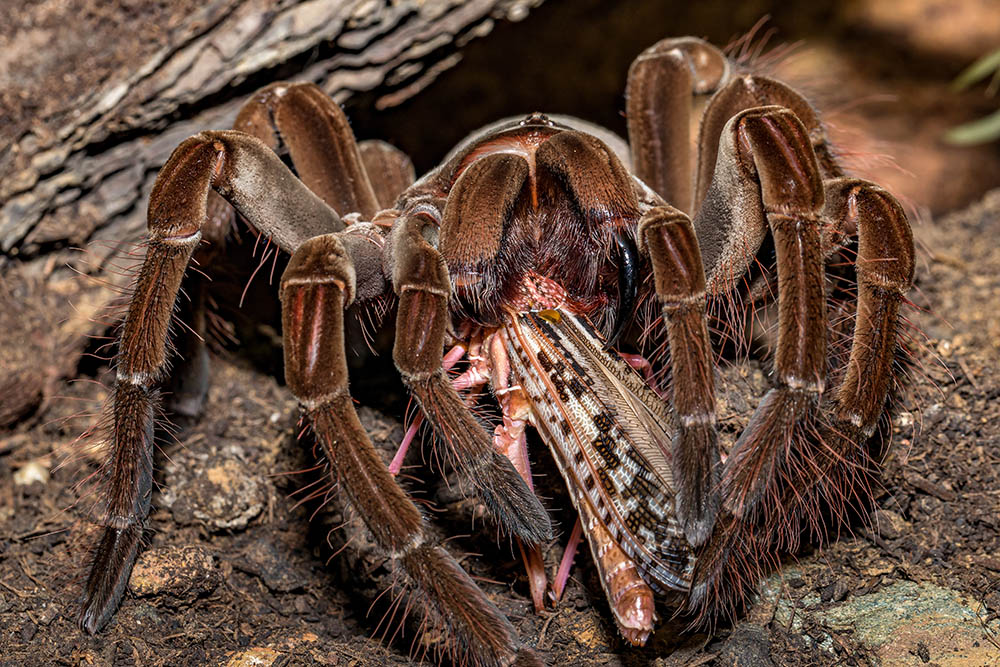
Foods Tarantulas Eat: A List
Tarantulas are carnivores that usually hunt when it’s nighttime. While they have a particular taste for insect meat, they also prey on many other types of animals that are smaller than them. Sometimes they prey on creatures bigger than them, as well. Thankfully, they haven’t developed a liking for human flesh, yet!
Below are the arthropods that typically comprise the tarantula diet.
- Beetles
- Cicadas
- Crickets
- Grasshoppers
- Horseflies
- Katydids
- Millipedes
- Moths
- Roaches
- Spiders
Tarantulas also eat worms, larvae, and worm-like arthropods including:
- Caterpillars
- Earthworms
- Hornworms
- King worms
- Mealworms
- Silkworms
- Superworms
In addition, tarantulas feed on small mammals, reptiles, and other animals such as:
- Bats
- Birds
- Fish
- Frogs
- Lizards
- Pinky mice (dead baby mice)
- Rodents
- Snakes
- Toads
As formidable apex predators, tarantulas are adept at hunting down their prey, and it’s all thanks to their lethal combination of intelligence, excellent senses, and effective hunting strategies that consider everything from their skill set to their environment.
While these arachnids typically focus on creatures equal to or smaller than their size, they’re known to attack those larger than them, as well.
The bigger the tarantula species, the bigger their prey, which explains why some tarantulas eat birds and snakes.
The largest tarantula species, the Goliath bird-eating tarantula, has a body that’s 4.75 inches (12 centimeters) long and a leg span reaching 11 inches (28 centimeters). That’s a whole lot of tarantula! And because they’re so big, they can also eat small mice, frogs, and birds such as hummingbirds.
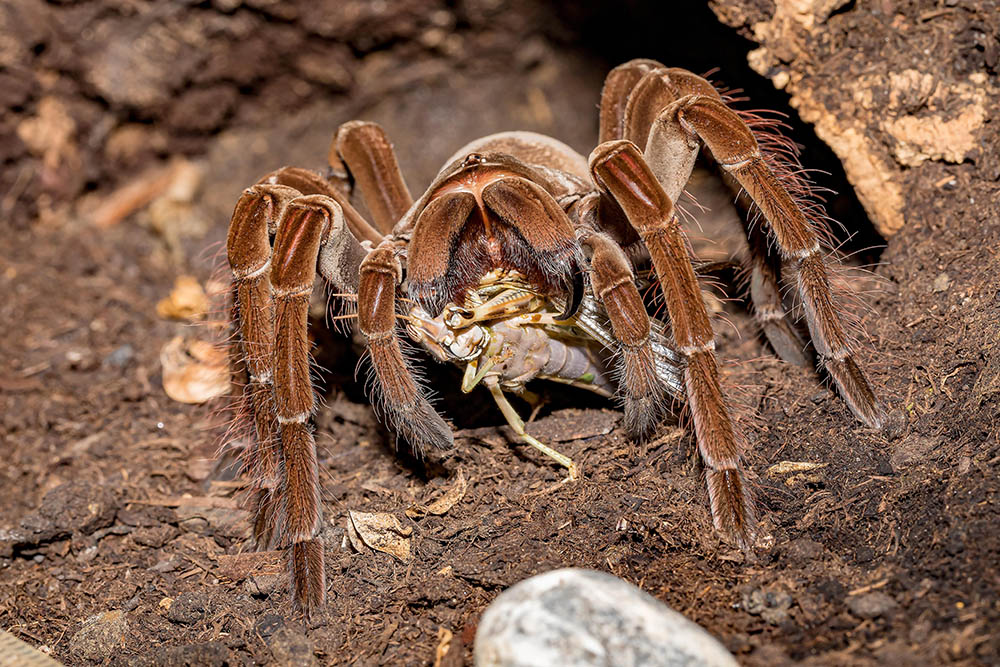
What Captive Tarantulas Consume
Like tarantulas that live in the wild, tarantulas in captivity need food and drink to survive. Below, we give some tips on how to satisfy a pet tarantula’s dietary requirements.
Food
A pet tarantula that’s kept in a tank remains a carnivore that requires live food sources to eat. Thankfully, you won’t have to catch spiders and birds to feed your spider; pet stores that specialize in reptiles and insects sell plenty of food suitable for tarantulas.
To keep a captive tarantula healthy, give it live, recently fed (a.k.a. gut-loaded) insects such as crickets, grasshoppers, Dubia roaches, moths, katydids, hornworms, mealworms, hornworms, superworms, and such.
If you own a huge tarantula, you can also feed it pinky mice (either thawed or frozen). Live creatures such as baby rodents, snakes, and lizards should also be good for your pet. Keep in mind that the size of any food you give your tarantula should always be no greater than its own.
You don’t have to take your pet out of its cage to feed it; you can simply deposit the food in its enclosure.
Immature tarantulas typically eat every day. While it’s a good idea to feed fully grown tarantulas once every two days, some are happy having a meal every 10 to 14 days. Others can even abstain from eating for up to a full month. Generally speaking, tarantulas avoid eating when they’re getting ready to lay eggs or are about to molt.
Because tarantulas are nocturnal, it’s best to give them food at night.
You shouldn’t give your tarantula more food than it can eat. If you put too many live insects in its cage, it will ignore them, giving them opportunities to harm your pet. A good practice is to remove any uneaten food from your pet’s cage around 10 minutes after it has finished its meal.
Drink
While tarantulas should be given water daily, avoid putting enormous amounts of water within your pet’s habitat as this could drown it. Provide it with tiny amounts of clean, fresh, chlorine-free drinking water instead, and refill its water dish once it’s empty. Make sure to replace the water in this dish every day, as well.
Because these arachnids usually get their hydration from the moisture of the plants within their enclosure, a small, shallow water dish will do.
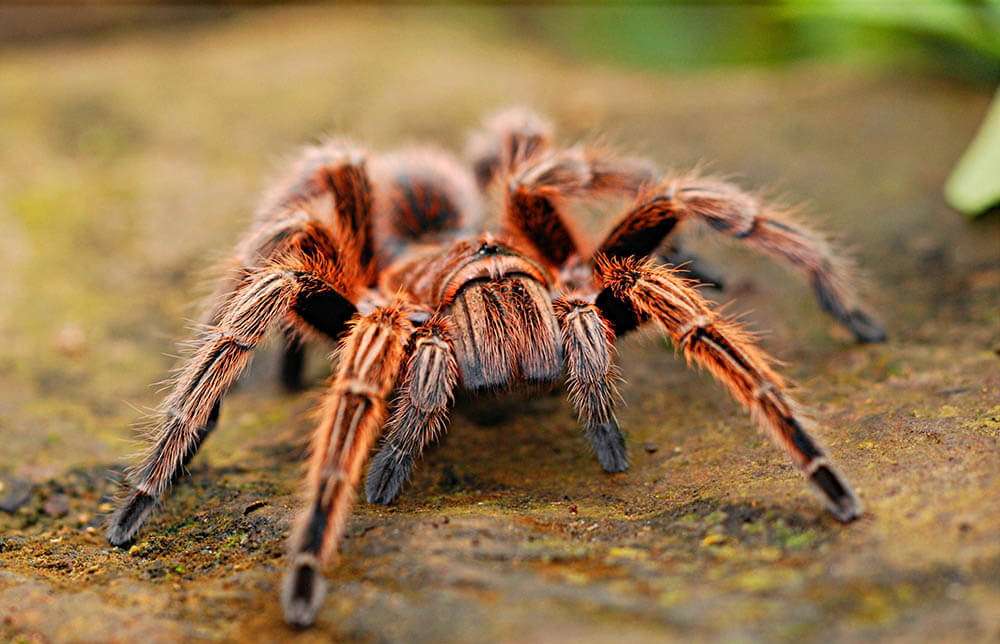
How Tarantulas in the Wild Hunt Their Food
Tarantulas are covered in tiny hairs that make them extremely sensitive to vibrations in their surroundings, including the air and the ground.
When vibrations disturb these hairs, a tarantula receives a glut of information about its surroundings which tells them about the presence of any animals within the vicinity. Thanks to this exceptional sensory ability, tarantulas can detect the sounds a prey animal makes (e.g. the “singing” of crickets) even if said animal is several meters away.
With ninja stealth, a tarantula sneaks toward its victim until it’s close enough for an ambush. It then sprints toward the hapless prey, catching it with a bite from its sharp fangs a.k.a. chelicerae. To neutralize this prey, the arachnid uses these fangs to inject paralyzing chemical-induced venom into its bloodstream. A digestive enzyme is also be released into the prey’s body, liquefying its flesh so that the tarantula can simply suck it up using the straw-shaped mouth below its fangs. These spiders also have powerful jaws capable of crushing their victims.
While tarantulas can spin webs, they don’t live on spider webs like most spider species do. Instead, they spend a lot of time in the burrows they create under dry soil. They line the burrow opening’s walls with silk, which can act as an alarm anytime a prey animal wanders close to their home.
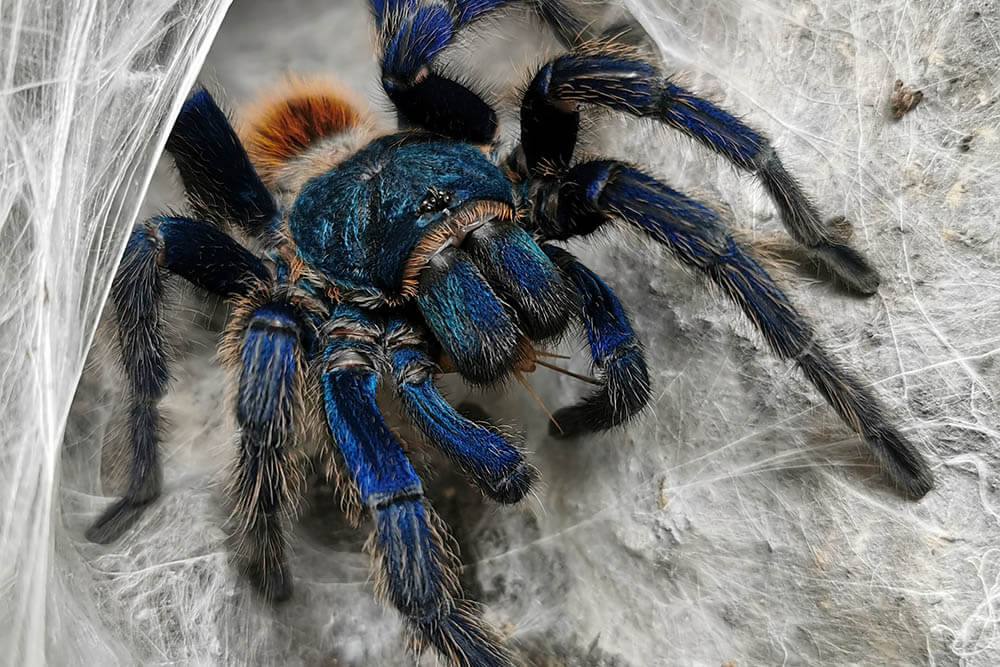
How Tarantulas Digest Their Food
Tarantulas boast a one-of-a-kind digestive system that comes with a feature known as a “sucking stomach.” This feature gives tarantulas the ability to ingest and digest the liquefied flesh of their victims.
Once its victim’s flesh has been converted into fluid, a tarantula contracts its strong stomach muscles, which pull said fluid up through its mouth and into its digestive system.
The tarantula stomach’s intestinal walls then break down larger fragments of food into smaller particles so that they can be absorbed into the bloodstream. This disperses the nutrients contained within the food throughout the spider’s body. Once the tarantula has had its fill, it crumples its victim’s carcass into a tiny ball, which it throws away afterward.
5 Fascinating Tarantula Facts
Would you like more information about these amazing creatures? Then check out some tarantula facts below!
1. They’re the least dangerous spiders in the world
Don’t let their size and intimidating appearance fool you; tarantulas are the least dangerous spiders on the planet. You’re more likely to get killed by a black widow, red widow, or a brown recluse spider than a tarantula.
This is because most tarantulas aren’t venomous. Even the venomous ones don’t always inject their venom into your bloodstream when they bite, so there’s often a good chance of surviving a tarantula attack.
2. Scientists know more than 1,000 tarantula species
True tarantulas are part of a large spider family scientists call Theraphosidae.
As of writing, scientists have discovered 1039 species of tarantula across 156 genera. Many of these live in deserts, the tropics, or the subtropics. While most tarantula species call South America home, these creatures are extremely widespread and diverse, inhabiting all the continents save for Antarctica.
3. They have amazing regenerative abilities
Tarantulas can regrow lost limbs through molting.
When these bugs molt, they replace their exoskeleton, which in turn repairs any damage they’ve suffered. A lost leg, for example, can be regenerated, with every successive molt lengthening the leg until it’s as long as the one that was lost.
4. Some species use their hairs to defend themselves from predators
Some tarantula species in the U.S. grow thousands of miniature tiny hairs on their abdomen. When an individual feels threatened by another animal, it rubs its hind legs rapidly over its abdomen. This loosens the aforementioned hairs and causes them to fling toward the source of danger. The hairs can get stuck in the predator’s mouth, eyes, or respiratory tract, neutralizing it and giving the tarantula a chance to flee.
It’s important to note, however, that these “hairs” aren’t really hairs in the mammalian sense of the word. Mammalian hair consists mostly of keratin. In contrast, tarantula hairs are made primarily of chitin, which is the same biopolymer found in arthropod exoskeletons.
5. They’re hunted by a specific wasp species
As fearsome as tarantulas look, they’re food for a wide range of animals. Tarantulas are usually hunted down and eaten by generalist predators such as coyotes, foxes, mongooses, opossums, coati, birds, frogs, lizards, and snakes.
One particularly terrifying predator is a wasp known as a tarantula hawk, which is a large specialist predator that preys primarily on tarantulas. This insect is equipped with a stinger that paralyzes tarantulas. Once the victim is paralyzed, the wasp lays one egg in its body. The wasp then seals the spider in a burrow. Upon hatching, the wasp’s offspring will start eating the living yet paralyzed arachnid – a horrible way to go for any creature!
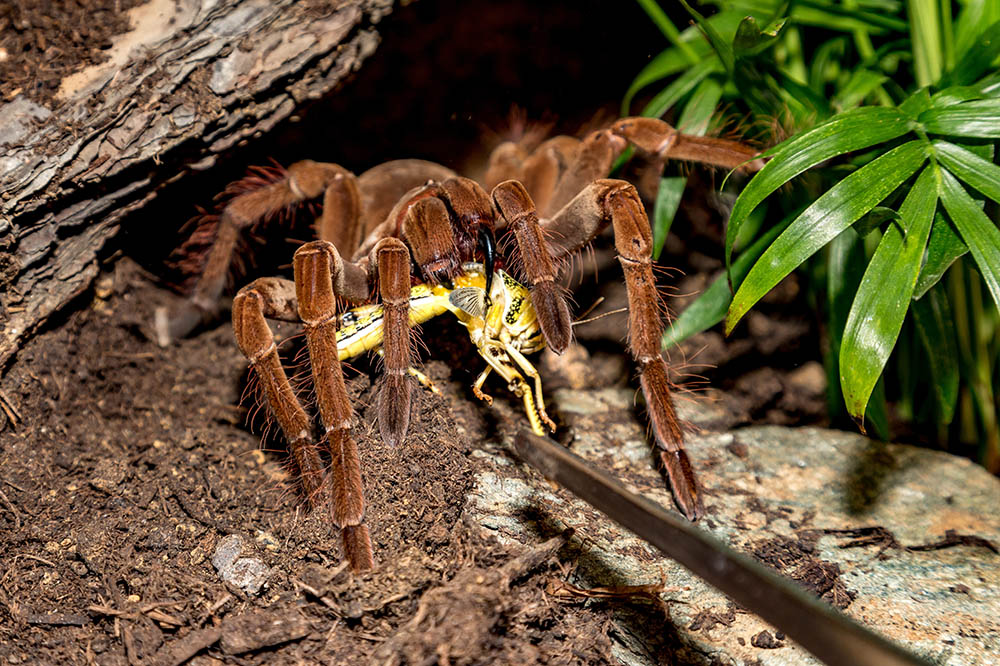
Conclusion
As carnivores, tarantulas prey and feed on a variety of creatures, including arthropods such as crickets, roaches, millipedes, and superworms; tiny rodents such as mice; and various small reptiles, birds, and fish.
If you’re considering becoming the proud owner of a pet tarantula, know that these creatures eat the same foods as their wild counterparts. Thankfully, you can purchase many of the prey creatures listed above from pet stores.
Keep your pet tarantula healthy and happy; feed them the right foods and ensure you satisfy their hydration needs!
